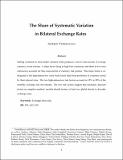| dc.contributor.author | Verdelhan, Adrien Frederic | |
| dc.date.accessioned | 2019-10-03T14:30:12Z | |
| dc.date.available | 2019-10-03T14:30:12Z | |
| dc.date.issued | 2017-11 | |
| dc.date.submitted | 2013-03 | |
| dc.identifier.issn | 0022-1082 | |
| dc.identifier.uri | https://hdl.handle.net/1721.1/122354 | |
| dc.description.abstract | Sorting countries by their dollar currency betas produces a novel cross section of average currency excess returns. A slope factor (long in high beta currencies and short in low beta currencies) accounts for this cross section of currency risk premia. This slope factor is orthogonal to the high‐minus‐low carry trade factor built from portfolios of countries sorted by their interest rates. The two high‐minus‐low risk factors account for 18% to 80% of the monthly exchange rate movements. The two risk factors suggest that stochastic discount factors in complete markets' models should feature at least two global shocks to describe exchange rates. | en_US |
| dc.language.iso | en | |
| dc.publisher | Wiley | en_US |
| dc.relation.isversionof | http://dx.doi.org/10.1111/jofi.12587 | en_US |
| dc.rights | Creative Commons Attribution-Noncommercial-Share Alike | en_US |
| dc.rights.uri | http://creativecommons.org/licenses/by-nc-sa/4.0/ | en_US |
| dc.source | Prof. Verdelhan via Shikha Sharma | en_US |
| dc.title | The Share of Systematic Variation in Bilateral Exchange Rates | en_US |
| dc.type | Article | en_US |
| dc.identifier.citation | Verdelhan, Adrien et al. "The Share of Systematic Variation in Bilateral Exchange Rates." Journal of Finance 73, 1 (February 2018): 375-418 © 2017 American Finance Association | en_US |
| dc.contributor.department | Sloan School of Management | |
| dc.relation.journal | Journal of Finance | en_US |
| dc.eprint.version | Author's final manuscript | en_US |
| dc.type.uri | http://purl.org/eprint/type/JournalArticle | en_US |
| eprint.status | http://purl.org/eprint/status/PeerReviewed | en_US |
| dc.date.updated | 2019-09-27T11:24:31Z | |
| dspace.date.submission | 2019-09-27T11:24:33Z | |
| mit.journal.volume | 73 | en_US |
| mit.journal.issue | 1 | en_US |
